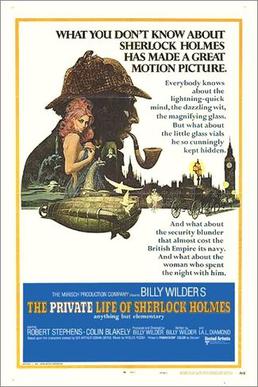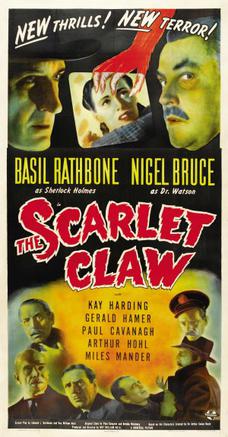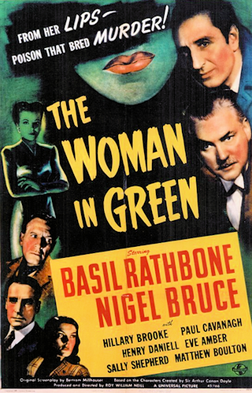
"The Adventure of the Sussex Vampire", written by British author Arthur Conan Doyle, is one of 12 Sherlock Holmes stories collected between 1921 and 1927 as The Case-Book of Sherlock Holmes. It was first published in the January 1924 issues of The Strand Magazine in London and Hearst's International in New York.

The Private Life of Sherlock Holmes is a 1970 DeLuxe Color film in Panavision written and produced by Billy Wilder and I. A. L. Diamond, and directed by Wilder. The film offers an affectionate, slightly parodic look at Sherlock Holmes, and draws a distinction between the "real" Holmes and the character portrayed by Watson in his stories for The Strand magazine. It stars Robert Stephens as Holmes and Colin Blakely as Doctor Watson.

A Study in Terror is a 1965 British thriller film directed by James Hill and starring John Neville as Sherlock Holmes and Donald Houston as Dr. Watson. It was filmed at Shepperton Studios, London, with some location work at Osterley House in Middlesex.

The Scarlet Claw is a 1944 American mystery thriller film based on Sir Arthur Conan Doyle's Sherlock Holmes detective stories. Directed by Roy William Neill and starring Basil Rathbone and Nigel Bruce, it is the eighth film of the Rathbone/Bruce series. David Stuart Davies notes on the film's DVD audio commentary that it's generally considered by critics and fans of the series to be the best of the twelve Holmes films made by Universal.
Sherlock Holmes and the Case of the Silk Stocking is a British television film originally broadcast on BBC One in the UK on 26 December 2004. Produced by Tiger Aspect Productions, it was written by Allan Cubitt and was a sequel to the same company's adaptation of The Hound of the Baskervilles, made for the BBC two years previously. Although Silk Stocking retained the same Dr. Watson, Ian Hart, this time the character of Sherlock Holmes was played by Rupert Everett.
The stories of Sherlock Holmes by Sir Arthur Conan Doyle have been very popular as adaptations for the stage, and later film, and still later television. The four volumes of the Universal Sherlock Holmes (1995) compiled by Ronald B. De Waal lists over 25,000 Holmes-related productions and products. They include the original writings, "together with the translations of these tales into sixty-three languages, plus Braille and shorthand, the writings about the Writings or higher criticism, writings about Sherlockians and their societies, memorials and memorabilia, games, puzzles and quizzes, phonograph records, audio and video tapes, compact discs, laser discs, ballets, films, musicals, operettas, oratorios, plays, radio and television programs, parodies and pastiches, children's books, cartoons, comics, and a multitude of other items — from advertisements to wine — that have accumulated throughout the world on the two most famous characters in literature."
Sherlock Holmes has long been a popular character for pastiche, Holmes-related work by authors and creators other than Arthur Conan Doyle. Their works can be grouped into four broad categories:
Many writers make references to Sir Arthur Conan Doyle's famous literary creation, the detective Sherlock Holmes, and these often become embedded within popular culture. While Holmes exists predominantly in the context of Victorian-era London, he has been mentioned in such outre contexts as the 22nd century or hunting aliens or supernatural enemies. These references are in addition to the innumerable passing references to Sherlock Holmes made in many literary and cinematic works, such as the labeling of a person as a "Sherlock", whether in reference to their intelligence.

The Hound of the Baskervilles is a 1939 American gothic mystery film based on the 1902 Sherlock Holmes novel of the same name by Sir Arthur Conan Doyle. Directed by Sidney Lanfield, the film stars Basil Rathbone as Sherlock Holmes and Nigel Bruce as Dr. John Watson. Released by 20th Century Fox, it is the first of fourteen Sherlock Holmes films produced between 1939 and 1946 starring Rathbone and Bruce.

The Woman in Green is a 1945 American film, the eleventh of the fourteen Sherlock Holmes films based on the characters created by Arthur Conan Doyle. Produced and directed by Roy William Neill, it stars Basil Rathbone as Sherlock Holmes and Nigel Bruce as Dr. Watson, with Hillary Brooke as the woman of the title and Henry Daniell as Professor Moriarty. The film follows an original premise with material taken from "The Final Problem" (1893) and "The Adventure of the Cardboard Box.

Sherlock Holmes Faces Death is the sixth film in the Basil Rathbone/Nigel Bruce series of Sherlock Holmes films. Made in 1943, it is a loose adaptation of Sir Arthur Conan Doyle's Holmes 1893 story "The Adventure of the Musgrave Ritual." Its three immediate predecessors in the film series were World War II spy adventures with Holmes and Dr. Watson helping the Allies thwart enemy agents, but this one marked a return to the pure mystery film form. Though several characters are military men and there are frequent mentions of the ongoing war, it is not the focus of the story.
Mrs. Hudson is a fictional character in the Sherlock Holmes novels and short stories by Arthur Conan Doyle. She is the landlady of 221B Baker Street, the London residence in which Sherlock Holmes lives.

A Study in Scarlet is a 1933 American pre-Code mystery thriller film directed by Edwin L. Marin and starring Reginald Owen as Sherlock Holmes and Anna May Wong as Mrs. Pyke. The title is taken from Arthur Conan Doyle's 1887 novel of the same name, the first in the Holmes series, but the screenplay by Robert Florey was original.

The Sleeping Cardinal, also known as Sherlock Holmes' Fatal Hour in the United States, is a 1931 British mystery film directed by Leslie S. Hiscott and starring Arthur Wontner and Ian Fleming. The film is an adaptation of the Sherlock Holmes stories by Arthur Conan Doyle. Although it is not based on any one particular story, the film draws inspiration from "The Empty House" and "The Final Problem". The film is the first in the 1931–1937 film series starring Wontner as Sherlock Holmes. It is unrelated to the Basil Rathbone series of Sherlock Holmes films that began in the late 1930s.

The Speckled Band is a 1931 British mystery film directed by Jack Raymond and starring Lyn Harding, Raymond Massey and Angela Baddeley. It is an adaptation of Arthur Conan Doyle's original 1892 story "The Adventure of the Speckled Band" and the 1910 play he adapted from it, The Speckled Band.

Sir Arthur Conan Doyle's Sherlock Holmes, also known simply as Sherlock Holmes, is a 2010 British-American steampunk mystery film directed by Rachel Lee Goldenberg and produced by independent American film studio The Asylum. It features the Sherlock Holmes characters created by Sir Arthur Conan Doyle, though it follows an original plot. The film details an unrecorded case in which eccentric detective Holmes and his companion Dr. Watson investigate a series of unusual monster attacks and a plot to destroy London. Gareth David-Lloyd plays Dr. John Watson and Ben Syder, making his film debut, plays Sherlock Holmes.

Dust and Shadow: An Account of the Ripper Killings by Dr. John H. Watson is a Sherlock Holmes pastiche novel by Lyndsay Faye which pits Sherlock Holmes against Jack the Ripper.
The Royal Scandal is a Sherlock Holmes film which is an amalgam of "A Scandal in Bohemia" and "The Bruce-Partington Plans". The film was produced in 2001 for The Hallmark Channel as part of an ongoing series of Hallmark Sherlock Holmes films.
Victorian Undead is a series of comics about Sherlock Holmes and Doctor Watson dealing with the supernatural. The first series Victorian Undead: Sherlock Holmes vs. Zombies is a six-issue American comic book limited series published by Wildstorm. The series was written by Ian Edginton, with art by Davide Fabbri. The story is set in Victorian England and follows Sherlock Holmes and Doctor Watson in the midst of a zombie outbreak. It was followed by Victorian Undead Special: Sherlock Holmes vs. Jekyll/Hyde and a second series, Victorian Undead: Sherlock Holmes vs. Dracula, which sees Holmes and Watson helping to track down the title character before he kills Queen Victoria.
"The Abominable Bride" is a special episode of the British television programme Sherlock. The episode was broadcast on BBC One, PBS and Channel One on 1 January 2016. It depicts the characters of the show in an alternative timeline: the Victorian London setting of the original stories by Arthur Conan Doyle. The title is based on the quote "Ricoletti of the club foot and his abominable wife" from "The Adventure of the Musgrave Ritual" (1893), which refers to a case mentioned by Holmes. The story also draws on elements of original Conan Doyle stories of Holmes such as "The Five Orange Pips" (1891) and "The Final Problem" (1893).











